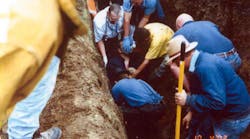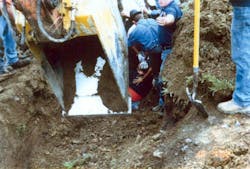In a silent room at the National Safety Council (NSC) Congress and Expo in Orlando, Fla., Eric Giguere shared his harrowing story of being buried alive more than 6 feet deep in a trench.
In the fall of 2002, Giguere was working with a small crew to install a sewer line in upstate New York. At first, their work involved installing pipe in 4-foot-deep trenches, a relatively safe operation that did not mandate special safety equipment. As the job progressed and the terrain and work conditions changed, however, that 4-foot trench gradually deepened to 4-and-a-half feet, then 5 feet, and so on until Giguere was working in a 6-and-a-half-foot-deep trench with no safety equipment.
“I’m a guy who got comfortable doing things the wrong way,” Giguere told NSC attendees. “I’m your average, hardworking guy. Essentially, I am any of you people in this room.”
Because the crew had been at work on the line for a few months, hadn’t experienced any problems and were making good money, they saw no need to address possible safety concerns. Oct. 4, 2002, “was just going to be another day at the job,” according to Giguere.
But it wasn’t just another day on the job. When a digging operation damaged a draining tile and dumped water in the ditch, Giguere and his fellow laborer jumped in to scoop out the water. Giguere’s coworker then climbed out to retrieve a piece of equipment while Giguere remained in the trench and began cleaning around the sides of the pipe.
Moments later, the trench collapsed.
In the Dark
“Without warning, in an instant – it was immediate – that trench caved in on me,” Giguere said. “It was pitch black, I couldn’t see, I couldn’t move. I was 100 percent helpless.”
For roughly a minute, Giguere remained conscious at the bottom of the trench after the dirt piled on him. When he exhaled, the dirt crushed his chest. He was trapped, and he could no longer breathe.
“I remember being down there kicking, scratching, clawing, fighting, and all that dirt kept packing in tighter and tighter,” he recalled. “I couldn’t move. I kept waiting to hear sound of a machine or a laborer calling my name, but I heard nothing. There came a point that I realized I was going to die right there at the bottom of that trench.”
Fortunately, the other laborer had heard Giguere’s initial scream when the trench collapsed. Now he and the other crewmembers had to make an excruciating decision: They could use the backhoe to scoop several feet of dirt out of the trench to reach Giguere, or they could grab shovels and start digging. Using the backhoe would remove the dirt much faster, but they risked striking Giguere with the equipment and killing him. Shovels would allow for safer digging, but would take much longer, meaning they likely wouldn’t reach Giguere in time to save his life.
“What choice do you make?” Giguere asked. “The bottom line is, that’s a terrible situation to put someone in. We forced a guy who’s working for $100 to $125 dollars a day to make a decision about my life. It’s a terrible situation to put someone in, and we forced it on him.”
In the end, the backhoe operator elected to remove the first few feet of dirt with the machine and, fortunately, did not strike Giguere. Next, the crew dug with shovels until they finally reached their buried coworker.
“I had no pulse, I was blue in the face, I had dirt caked into my mouth,” Giguere said. “Imagine putting someone here in that room in that position because you were trying to save time [by taking a safety shortcut].”
Giguere estimates he was in the trench for about 10 minutes. After receiving CPR from the crew operator and shocks from emergency personnel, Giguere recovered “a slight pulse,” was put on life support and rushed to the hospital.
A Walking Miracle
The nightmare was not over yet for the crew on site. They had to call Giguere’s wife of 6 days to give her the news that he had been involved in a serious accident and might not survive.
“Think about calling someone’s family and telling them that,” Giguere said. “The doctor tells her they don’t think I’ll make it through this, and if so, I’ll have severe brain damage. For what? To save a little time out there?”
At first, the doctors expected Giguere would not survive. If he did make it, they said, he’d suffer extensive brain damage.
What happened in the end surprised everyone – within a week of the trench collapse, Giguere walked out of the hospital. He left with painful bruises, cuts, cracked ribs and three holes in his brain, but he was alive.
“You are looking at a walking miracle,” Giguere said. “People don’t spend 10 minutes down there and talk to you. They die.”
The Nightmare Continues
Giguere might have survived, but his life was never the same. From the first day home, when he was too terrified to have a blanket on top of him or to sleep in the dark, he suffered. He endured sleepless nights, damaged memory and agonizing therapy sessions that entailed sitting in a tiny, dark room that brought those devastating moments in the bottom of the trench flooding back.
“We take shortcuts [at work] to save time, but I lost 2 and a half years of my life,” he said. “Imagine everything you do outside of work completely stopped for the next 2 and a half years. I’m tired all the time because I can’t sleep, I’m frustrated because can’t remember anything. That shortcut has changed everything about my life.”
A decade after the trench collapse, Giguere still can only sleep about 3 hours a night and continues to wake up with nightmares. He claims he came out of that trench a different person – so different, in fact, that he and his wife were not able to endure the stresses of their new life. They eventually divorced.
“Everything I was working my tail off for out there, everything that was important to me in my life is gone because I wasn’t willing to make safety a priority. Are you guys willing to risk everything that’s important in your life?” Giguere asked. “We’re not some machine we can run out and repair. That’s not the way it works.
“It’s too late for me,” he continued. “But it’s not too late for you guys to make sure you do it the right way and choose the safe way every day.”
Taking Responsibility
Despite the fact that the contractor Giguere worked for did not enforce safety rules and in fact encouraged improper procedures to save time or effort, he only blames one person in the end: himself.
“I don’t completely blame my company for what happened to me that day. The truth is this: Every day we go to work and make adult decisions. I made a choice to do it and I take responsibility for what happened,” he said.
This is Giguere’s view even in light of the company’s deceit: In the hours after the trench collapse, the contractor shipped a trench box to the site to make it appear that safety equipment was on hand but simply went unused. An OSHA inspector on location witnessed the trench box’s late arrival. (Giguere admitted that even if a trench box had been on site at the time, he and his coworkers would not have used it.)
The contractor, who had been fined six times by OSHA for previous safety violations, received one willful violation for $54,000 for this incident. OSHA and the company later negotiated this amount down to less than half the original fine. For his part, Giguere received no settlement from the company.
Giguere’s message today is simple: Don’t take shortcuts. Respect safety requirements. Don’t make a choice that could put yourself, your coworkers and your family in life-altering situations.
“Every hard decision that my coworkers were forced to make, every emotion my families and friends felt, every thing I went through at the bottom of that trench happened in less than a second,” he said. “Less than a second is all it took to put people in that situation. Are you willing to put your families through that to save a little time out there? If it happened to me, it could happen to anyone. One second is all it takes to change your life if you don’t make safety a priority.”


